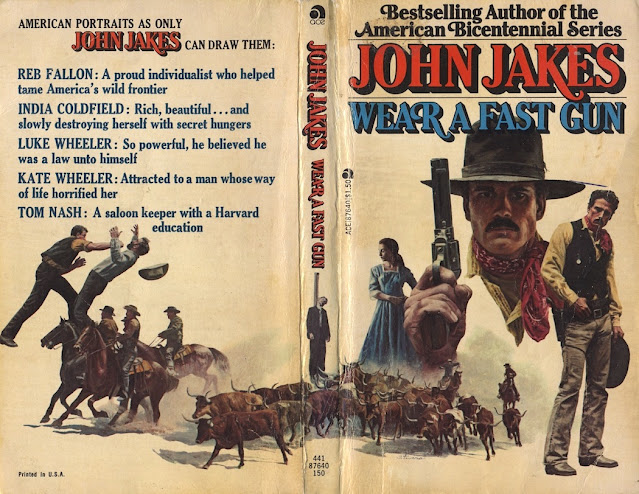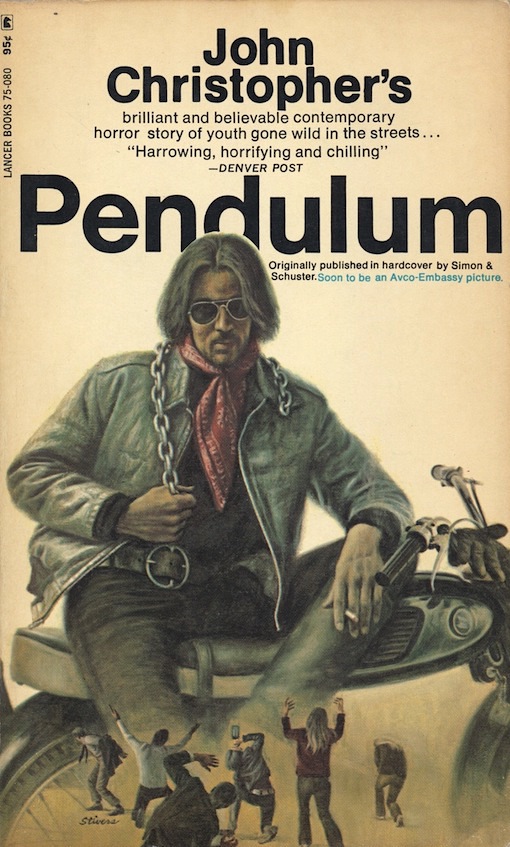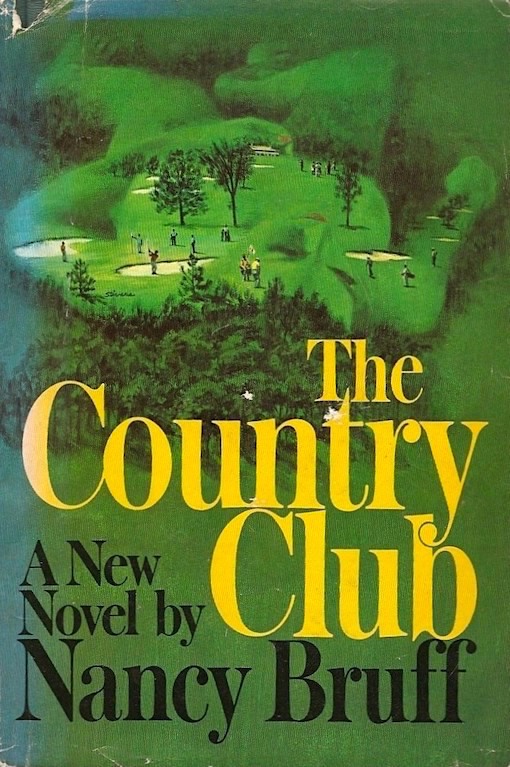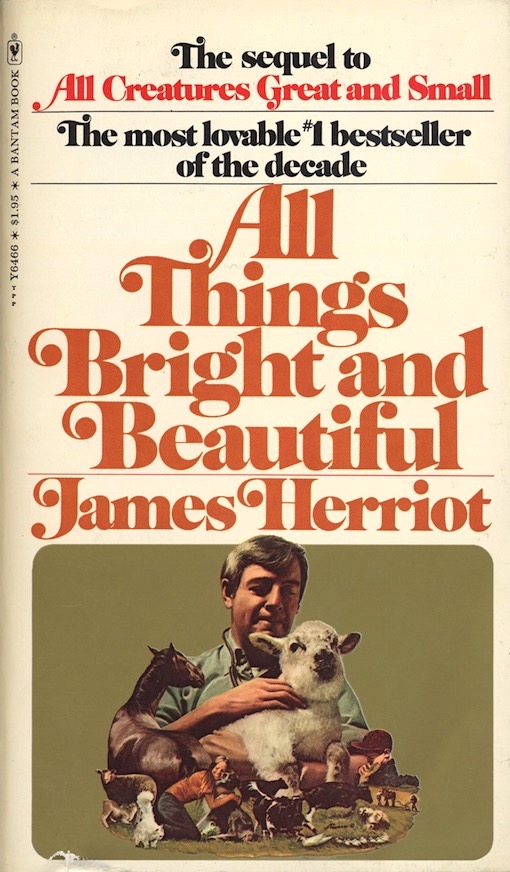 |
| CLICK ON IMAGE TO ENLARGE |
Don Stivers (1926- 2009) will forever be remembered as one of our nation's leading illustrators of American Military History. His hundreds of outstanding paintings, ranging from
the Revolutionary War to the Civil War to the Iraq War, can be found in numerous military
and civilian museums all across the United States and in thousands of
personal collections all over the world. Of special note perhaps are his historically accurate depictions of the famed members of
the 9th, 10th, 24th and 25th Calvary Regiments of the United States
Army, otherwise known as the Buffalo Soldiers (shown above is The Redoubtable Sergeant Emanuel Stance, © 1997). These uniquely American works have become very popular with print collectors and if you happen to own one of his original paintings, well, you're in a much grander place than I am. But before Stivers hit his stride with historical themes he began his career like a lot of other artists of his generation by producing cover art for hardbacks and mass-market paperbacks. He also created movie posters for Hollywood, advertising art, interior illustrations for books, and cover art and interior illustrations for national magazines such as Reader's Digest, Time--and my all-time boyhood favorite, Field & Stream.
Here is Don Stivers netting the big one, on the February, 1968 cover of Field & Stream magazine.
Here's a halfsheet poster (top) by Don Stivers promoting Robert Aldrich's 1972 western film, Ulzana's Raid, and its subsequent re-use on the 1993 MCA Home Video VHS box liner (bottom).
Stivers also worked for the toy manufacturer Hasbro during the 1970s. His colorful packaging art on their products are not only greatly admired, but eagerly sought after by G.I. Joe collectors.
Avon published Charles Mercer's Promise Morning in September, 1967, and I've yet to find an earlier paperback with Stivers' art on it. Mercer, a WWII veteran, was for most of his life an editor at Putnam, off and on that is since 1949, and when he wasn't pouring over someone else's manuscript he was hammering out his own, eventually producing 12 non-fiction books and 17 novels, including a bestseller in 1956. Rachel Cade, like its thematic sequel Promise Morning, was a powerful fictional account of real events in the African Congo.
 |
| CLICK ON IMAGE TO ENLARGE |
It was likely that Stivers was instructed by his art director to use a variation of the composition that was already on the hardcover edition of Frank Elli's real-life inspired prison novel The Riot (Coward-McCann, 1966), while formulating his own "Up Yours" cover art for the forthcoming January, 1968, Avon paperback
edition. To me it's a significant improvement over Paul
Bacon's earlier design, but to each his own prison yard I guess.
Stivers raised a powerful fist for his cover art on the acclaimed World War II tugboat novel The Captain. Avon published this paperback edition in May, 1968. Dutch born and eventual pacifist Jan de Hartog wrote many of his novels based on his own life experiences as a seaman, which began as early as age 11, when he ran away from home to become a cabin boy on a fishing boat. Though ironically, it was his The Peaceable Kingdom (1972), a land-locked novel about Quaker life, that got him his one and only nomination for the Nobel Prize. From 1960 on he and his wife lived mostly in Houston, Texas, where upon his death in 2002 his ashes were scattered at sea, from, you guessed it right, an ocean-going tugboat.
Stivers raised a powerful fist for his cover art on the acclaimed World War II tugboat novel The Captain. Avon published this paperback edition in May, 1968. Dutch born and eventual pacifist Jan de Hartog wrote many of his novels based on his own life experiences as a seaman, which began as early as age 11, when he ran away from home to become a cabin boy on a fishing boat. Though ironically, it was his The Peaceable Kingdom (1972), a land-locked novel about Quaker life, that got him his one and only nomination for the Nobel Prize. From 1960 on he and his wife lived mostly in Houston, Texas, where upon his death in 2002 his ashes were scattered at sea, from, you guessed it right, an ocean-going tugboat.
Because this is one of Stivers's most handsome portraits on a paperback cover I was motivated to include a picture of the book's author too, the lovely Margaret "Garet" Rogers Miller
(1920-1996). She was a lawyer and a long-time Hollywood resident who wrote seven
moderately successful novels between 1954 and 1965. I also read somewhere that she was the
first woman ever to run for mayor in the state of California (Los
Angeles, 1960), but I've not been able to verify that important, if
true, claim. Her medical novel The Jumping Off Place was published in paperback by Dell in March, 1968.
This is just one of several covers that Stivers produced showing an airplane in motion, but the handheld pistol makes this one even more interesting. Lionel White (1905-1985), who also wrote as L. W. Blanco, specialized in crime fiction, with a bent towards caper plots. His early novels were published as paperback originals by Fawcett Gold Medal but eventually he received hardcover treatment by publisher E. P. Dutton. White wrote 38 novels, his first in 1952 and his last in 1978, and quite a few of his books were made into feature films. Hijack was published in paperback by Macfadden in 1969.
Stivers' flavorful skull candy gives us the impression that this is a horror novel but in fact Cargo of Eagles is pretty much a straight forward mystery, and a good one at that. It was the nineteenth and final entry in Margery Allingham's famed Albert Campion series, but actually completed after her death, and at her prior insistence, by her husband Philip Youngman Carter. Macfadden published this, the very first US paperback edition, in 1969.
Stivers conjured up a tough looking bloke for his cover of Pendulum, British writer John Christopher's exciting but decidedly grim novel about "folk-rock" culture gangs ruling England by mob force after a period of economic crisis and collapse. I guess this was right before "punk-rock" emerged. It was published in paperback in the US for the first time by Lancer in 1969.
 |
| CLICK ON IMAGE TO ENLARGE |
I broke 80 twice and eagled twice before I eased up on golf, but had I been able to play at this stunning golf course designed by Don Stivers I might've bagged a hole-in-one too! Nancy Bruff''s hardcover novel The Country Club (Bartholomew House, 1969) was a sort of soft precursor to the kind of sleazy novels that ejaculated (sorry, bad pun) throughout the 1970s and 80s by writers such as Hugh Barron, William Hegner, Burt Hirschfeld and Stephen Lewis. And wouldn't you know it, circumstances being what they always are, the sexy cover art on the Dell paperback edition that was issued a year later was painted by none other than Victor Livoti, who, in addition to being a scratch golfer himself, was one of Stivers' best buddies.
Stivers' cover art perfectly captures the spirit of Stirling Silliphant's novel Maracaibo in all ways except one: Yes, he illustrates the hot love story triangle; And yes, he illustrates the off-shore oil rig fire; And yes, he illustrates the scuba diving--but what Stivers didn't capture was the impending hurricane--but hey, shouldn't something be left to our imagination? Macfadden published this paperback edition in 1970.
Murphy's War was published in paperback by Dell in 1970. The novel follows the travails of a lone-survivor of a torpedoed Royal Navy ship who is hellbent on exacting revenge on the German U-boat that was responsible for his crew's demise. The setting is the equatorial coast of Africa at the close of World War II, and as the cover blurb suggests a motion-picture was indeed made of Max Catto's novel. It was released in 1971 and it starred Peter O'Toole and Siân Phillips, among others. I believe Stivers had access to early publicity photos because his couple share more than just a coincidental resemblance to the actors.
Wow! If this isn't the best cover art on a medical novel EVER then you'll find its superior hanging as a bona fide treasure in our nation's National Gallery. Dell published Security Surgeon in paperback in August, 1970, under the pseudonym Kerry Mitchell. The author, J. E. (James
Edmond) MacDonnell (1917-2002), wrote more than 200 novels about naval
operations at sea, many of them while he was still a commissioned
gunnery officer in the Royal Australian Navy. His
medical series consisted of maybe just fourteen titles but he also wrote
juveniles and at least a dozen novels in the Mark Hood espionage series under the pseudonyms James Dark and J. E. Dark.
 |
| CLICK ON IMAGE TO ENLARGE |
Here's a marvelous western montage by Stivers and a forerunner of the type of historical subject that would later be painted by him in droves. Wear A Fast Gun was initially published in 1956, and then reprinted by Ace in paperback in 1974, and it too was a forerunner of what was to come from its author, the Chicago born John Jakes. His Kent Family Chronicles and North and South historical fiction series were both bestsellers during the 1970's and 80's and each spawned a television series but Jakes also wrote successfully in almost every genre that there was including sword & sorcery and science-fiction.
Hawker "Hawk" Lane is a pro football player and a lawyer who is feels obligated to represent the interests of a fellow teammate killed in a suspicious car accident. During his investigation he gets beaten over the head, menaced by guns, drugged, and, yes, laid, because that's the way all scrimmages were conducted back in the Stylin' Seventies. Stivers of course captures the cool essence of the Hawk quite well on the cover of the 1975 Ace paperback edition. Milton J. Shapiro specialized in biographies of sports figures and war subjects and The Hawk was probably meant to be the beginning of a new direction for him, one of crime fiction series writing, but instead it became just a one-off, and that's too bad because it made for some great hard-boiled reading.
It looks to me as if Stivers used the likenesses of of then popular actors Lee Majors and Farrah Fawcett to enhance his montage on Robin Moore's 1976 conspiracy thriller The Terminal Connection, published in paperback by Ace. Moore's writing career got jump-started in the early 1960's by his "fictionalized" non-fiction books The Green Berets and The French Connection. By literary necessity he became an extensive researcher, war historian and world traveler, and by the time he died in 2008 at the age of 83 he had cranked out a total of 62 books. At his funeral, and befitting one who was beloved by many in America's Special Forces, he was eulogized by high ranking members of the military and then given full military honors.
Murder Without Icing, By Hook or Crook, and Murder to Go were all published in paperback by Pocket in 1977. I'm fairly certain that there are two more John Putnam Thatcher Mysteries from Pocket that have cover art by Stivers, but they eluded me thus far. Emma Lathen is actually two authors, economic analyst Mary Jane Latsis and attorney Martha Henissart, and even though their novels have been well received when I tried to read one it stalled out on me like a bad outboard motor. Every author deserves a second chance though, especially one with double the horsepower, so yes, I will be giving Emma Lathen another pull on the starter-cord someday.
In the 1970s Stivers painted the cover art on all three St. Martin's Press US hardback editions of British writer James Herriot's bestselling veterinarian fiction series. Each fix-up novel (All Creatures Great and Small, All Things Bright and Beautiful, All Things Wise and Wonderful) was derived from several original United Kingdom publications, and after the hardback played out they were then reissued the following years in mass-market paperback by Bantam, starting in 1973, 1975 and 1978, respectively. My copy of All Creatures Great and Small is actually the 42nd Bantam printing (1980), which reveals just how incredibly popular Herriot was on this side of the Atlantic.
 |
| CLICK ON IMAGE TO ENLARGE |
"Will You Give Us Our Whiskey Now? (if we take it)!" illustrates a decisive moment during the Civil War, where the 51st's of both Pennsylvania and New York seized the Rohrbach Bridge over Antietam Creek (also known as Burnside's Bridge) from Confederate forces during the bloodiest one day battle in US history. The PA 51st had had their
whiskey rations cut due to misconduct on the march, so when a corporal
proposed the deal of whisky rations returned if they took the bridge, their Brigadier General (Edward Ferrero) was more than happy to oblige.
And take it they did!
And take it they did!
If you would like to purchase a giclée print of this 1995 painting by
Don Stivers, or choose from dozens upon dozens of other exceptional prints, including some of Don's original oil paintings, then please visit the Stivers website at https://www.donstivers.com. Perhaps for the sake of this post I can be allowed to rename the above illustration to read: "C'mon boy's, follow me to Stivers! There's great ART to be had there!"
[January, 2020, © Jeffersen]










...jpg)















